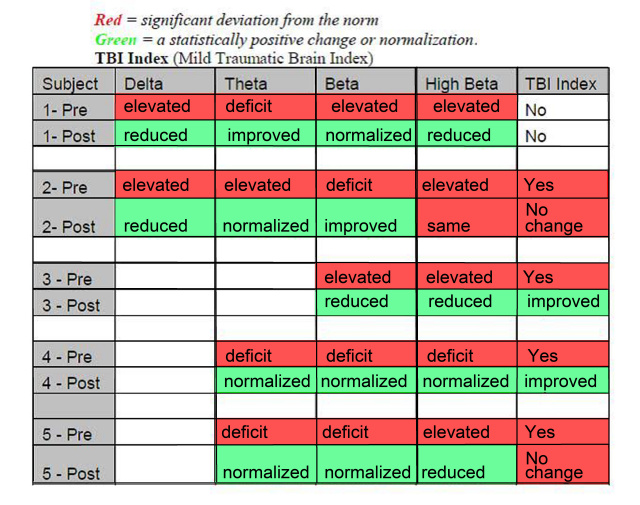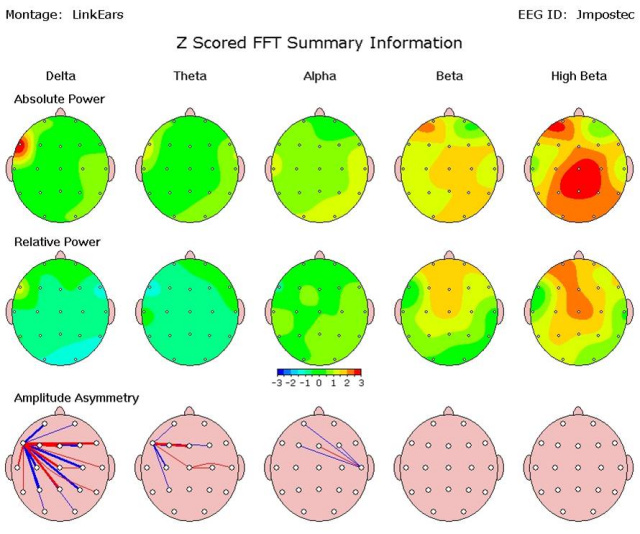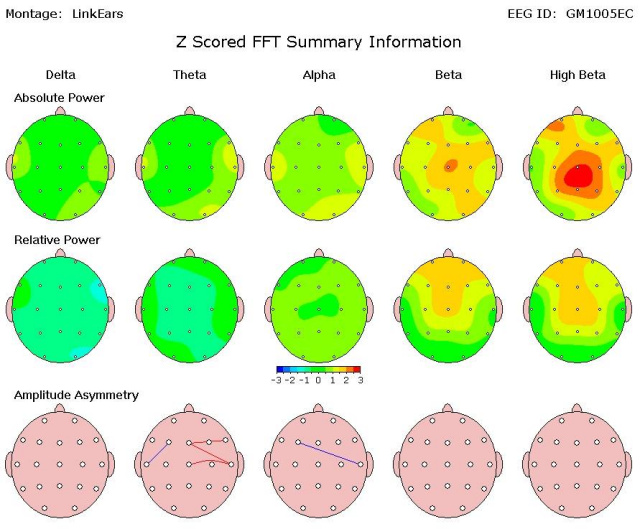|
QEEG Pilot Study Results
The information on this page reflects the Scientific Arts Foundation efforts
to increase public awareness of a clinical trial designed and IRB approved in 2007.
The video clip below is from an event at the St. Louis Science Center
in June 2008 where researchers shared their pilot study data.
Effects of a Relaxation CD on Stress Factors
In Cancer Patients Receiving Chemotherapy
as Measured by Quantitative EEG: A Pilot Study
According to the American Cancer Society, cancer is the second leading cause of death in the US. In the year 2006 about 1,220,100 new cancer cases will be diagnosed and about 552,200 Americans are expected to die of this disease. Research has shown that stress can compromise the immune system and therefore may become a significant factor for cancer patients (Anderson et al., 1998; Boermeester & Butzelar, 1999). Music has often been used as a stress-reliever and there is much research to support this as a therapy. This pilot study looked at the effects of "The Magic Mirror" solo harp CD by Amy Camie.
Five subjects were enlisted in this study. Each subject was given a Quantitative EEG (QEEG) pre and post treatment. After the pre QEEG they were instructed to listen to "The Magic Mirror" CD once a day for ten consecutive days. They were also instructed to fill out a daily questionnaire. At the end of the ten day listening period a post QEEG was done.
The QEEG data was analyzed by Dr.Rober Thatcher's normative database (NeuroGuide). Each subject’s data was looked at in terms of the degree to which it deviated from the norm. The spreadsheet below is a summary of the findings. It is color coded so you can see at a glance that each subject showed pre study indications of EEG abnormalities and significant changes in the post QEEG. The categories (Delta through High Beta) are EEG frequencies (see definitions below) and Asymmetry through TBI Index are ways of looking at the cortex’s efficiency at processing information (see definitions below).

Additional images
Pre Quantitative EEG images of volunteer cancer patient JM:

Elevated Delta, Elevated High Beta, Abnormal Alpha / Asymmetry
Post Quantitative EEG images of volunteer cancer patient JM
after listening to The Magic Mirror solo harp CD once a day for 10 days:
Normalized Delta, Reduced High Beta, Normal Alpha
Frequency
Frequency refers to the rate at which a brainwave repeats its cycle within one second. The number of cycles per second is called “hertz” (Hz). The more times a brainwave repeats its cycle per second, the FASTER it is said to be. Some practitioners divide the frequency of brainwaves into categories:
Delta (0.1-3 Hz):
Distribution: generally broad or diffused, may be bilateral, widespread
Subjective feeling states: non-REM sleep, when awake – an internal focus
Theta (3-8 Hz):
Distribution: usually regional, may involve many lobes, can be lateralized or diffuse;
Subjective feeling states: intuitive, creative, switching thoughts, drowsy;
Alpha (8-12 Hz):
Distribution: regional, usually involves entire lobe; strong occipital w/eyes closed
Subjective feeling states: relaxed, not agitated, but not drowsy; tranquil, conscious
Low Beta (12-15 Hz), formerly "SMR":
Distribution: localized by side and by lobe (frontal, occipital, etc)
Subjective feeling states: relaxed yet focused, integrated
Midrange Beta (15-18 Hz):
Distribution: localized, over various areas. May be focused on one electrode.
Subjective feeling states: thinking, aware of self & surroundings
High Beta (above 18 Hz):
Distribution: localized, may be very focused.
Subjective feeling states: hyper alertness, agitation
Cortical Processing:
Sensory integration is an innate neurobiological process and refers to the integration and interpretation of sensory stimulation from the environment by the brain. For us to adequately understand the world around us we need to effectively interpret and process all the information our senses take in. Asymmetry refers to similar signal strength across areas of the cortex that are doing the processing. Different signal strengths decrease information processing efficiency. Coherence is another aspect of cortical processing which impacts efficiency. Inclusion in the TBI Index indicates QEEG similarities with a traumatic brain injured population.
The indications that can be drawn from this pilot study are:
1. The Magic Mirror relaxation solo harp CD has a significant effect on EEG frequencies
2. The frequencies most affected are the High Beta and Theta.
3. A general comment that can be made is that The Magic Mirror relaxation solo harp CD calms and quiets the brain resulting in greater ability to focus and process information.
Comment on Study:
There are a number of important facts that need to be considered when reviewing the data. The subject EEG data was processed through one of the most reputable database available. Dr. Thatcher has been published in the most prestigious peer review journals in neurology. Subject EEG is being compared to normative data and only deviation from the norm is considered. Neurological functioning as measured by EEG is approaching normal. The intervening variable (treatment) is The Magic Mirror solo harp music written and recorded by Amy Camie. By using a normative database the results are indicating a significant change in critical EEG functions. Subjective reports from the subject’s daily log indicated a daily positive effect of the music. This is subjective whereas the EEG data is not.
Further Comments on Study
by William Collins, Ph.D.
Of the many things that can be said about cancer, one thing is undeniable,it is enormously stressful. There is emotional and physical stress, as well as stress that compromises the immune system. This stress directly affects the ability of a person to handle their daily life while in treatment, and may have a great deal to do with the ability of a person to survive and thrive despite the cancer. In the volume of studies that have been done on cancer, a high percentage have looked at this stress factor.
This pilot study was designed to test the effects of solo harp music on stress. Would solo harp music, if used consistently during treatment, make a difference? How would we measure this?
The specific measure used in this case was quantitative EEG. Since the brain is the central control for most things that occur in the body, it was felt that this would be an appropriate measurement.
A normative database was used to compare subject’s brain functioning before and after listening to the music for ten consecutive days. In another pilot study I had looked at a particular brainwave frequency that is associated with relaxation. The design of that study was to see whether this relaxing frequency increased, decreased or stayed the same.
This study was designed to be slightly more sophisticated in that we were comparing the subject’s brain wave frequencies with those of a normal population. This way we could see not only if there was any change but whether that change was significant when comparing it to a normal population. Basically, how did our subjects fare when compared to the average population’s brains? These were brains that did not have to deal with cancer, treatment or the effects of either. They were the norm – how would we stack up against the norm?
The results were in a direction that was totally unexpected. I had supposed that certain frequencies related to stress or relaxation would change. Solo harp music is very relaxing and enjoyable. This would be a reasonable expectation.
What I didn’t expect was that fundamental brain functioning would change. In each of the subjects the pre qEEG report indicated specific areas of deviation from the norm or decreased functioning.
In other words, listening to solo harp music had a direct positive effect on the subject’s neurological functioning, not simply increasing or decreasing stress responses.
In future studies the research could focus on:
1. Validating the pilot study by using a larger sample size.
2. Isolate factors that contribute to stress and decreased processing efficiency.
3. Increase the time subjects listen to the CD to determine if the effects increase or not.
4. Do post cancer treatment QEEG to determine if QEEG normalizes without the use of the CD.
5. Determine if this one aspect impacts the subject’s cancer progression in time and size.
This pilot study was conducted by William Collins, Ph.D. www.rhistl.com
Read about our Saliva Pilot Study Results
For information on how to purchase "The Magic Mirror" CLICK HERE
|